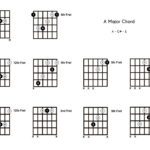For any aspiring blues guitarist, understanding chord progressions is absolutely fundamental. Blues music, the bedrock of countless modern genres, is built upon relatively simple yet incredibly expressive chord structures. Getting to grips with these progressions not only unlocks the door to playing the blues but also provides a crucial framework for understanding music theory and jamming with fellow musicians.
This guide is designed for beginner guitarists who are eager to delve into the world of blues. We’ll break down the essentials of blues chord progressions in a clear, step-by-step manner, assuming no prior knowledge of chords or music theory. Our focus will be on the most iconic blues structure: the 12-bar blues.
What are Chord Progressions and Why They Matter in Blues?
In music, a chord progression is simply a sequence of chords played one after another. Think of it as the harmonic backbone of a song. In blues music, chord progressions are not just a background element; they are the very essence of the form. The way these chords are arranged and played creates the distinctive blues feeling – that mix of melancholy, soulfulness, and raw energy.
Learning chord progressions is crucial because:
- Blues is built on them: Almost every blues song you hear is based on a specific chord progression. Knowing these patterns allows you to immediately recognize and play along with countless blues tracks.
- Foundation for improvisation: Chord progressions provide the harmonic landscape for blues solos and melodies. Understanding them is essential for improvising and creating your own blues licks.
- Jamming and collaboration: Blues progressions are a universal language among musicians. Knowing them enables you to jump into jam sessions and play with others, regardless of your specific blues song repertoire.
The Foundation: The 12-Bar Blues Chord Progression
The cornerstone of blues music is the 12-bar blues chord progression. This progression is a repeating pattern of three chords that spans 12 musical measures, or “bars.” In blues, each measure typically contains four beats. The three chords used in this progression are always drawn from the key of the song.
To illustrate, let’s start with the 12-bar blues in the key of E, a very common key for blues guitar.
12-Bar Blues in the Key of E
Here’s the standard 12-bar blues progression in E:
As you can see, it utilizes only three chords: E7, A7, and B7. These are all Dominant 7th chords, characterized by the “7” in their name. Dominant 7th chords have a distinctive, slightly dissonant, and bluesy sound. They are frequently used in blues progressions to create that characteristic harmonic tension.
If you’re new to these chords, here are common and beginner-friendly ways to play them on guitar: (Diagrams or links to diagrams would be helpful here in a real article, but we’ll assume basic knowledge for this exercise).
To play this progression, you would simply choose a strumming pattern with four beats per measure and apply it to each chord in the sequence. The possibilities for strumming variations are vast, allowing for a wide range of rhythmic feels within the same chord progression.
Understanding Keys, and the I-IV-V Chords
To understand how the 12-bar blues works in different keys, we need to grasp a fundamental concept in music theory: keys and chord numbering.
Every musical key has a set of seven core chords that are harmonically related to it. In music theory, these chords are often represented by Roman numerals (I, II, III, IV, V, VI, vii). The 12-bar blues progression is built using the I, IV, and V chords of any given key.
In the key of E, as we saw:
- I chord is E7
- IV chord is A7
- V chord is B7
Notice that the I chord shares the same root note as the key itself (E in the key of E). The IV and V chords are always a specific musical interval away from the I chord. On the guitar fretboard, this translates to consistent physical relationships.
Finding I-IV-V Chords on the Guitar Fretboard
The fretboard diagram below illustrates how to locate the root notes of the I, IV, and V chords relative to each other on the 6th and 5th strings:
This method requires you to know the notes on your 6th and 5th guitar strings. Learning these notes is a valuable skill for any guitarist, even beginners. Here’s a quick reminder of the notes on these strings: (Diagram of 6th and 5th string notes could be included here).
To use this diagram, find the root note of your I chord on the 6th string. The root notes for the IV and V chords will then be positioned directly below it as shown.
For example, in the key of E: The root note E is on the open 6th string. Following the diagram, the root of the IV chord (A) is directly below on the open 5th string. The root of the V chord (B) is two frets higher than A on the 5th string. Once you find these root notes (E, A, B), simply form Dominant 7th chords using them (E7, A7, B7), and you have your blues chords in E.
Blues Chord Progressions in Different Keys
Let’s walk through another example to solidify this: the 12-bar blues in the key of G.
First, locate the root note of the I chord (G) on the 6th string. This is at the 3rd fret. Using the fretboard relationship diagram, the root of the IV chord is on the same fret but on the 5th string, which is the note C. Moving two frets up from C on the 5th string gives us D, the root of the V chord.
So, in the key of G:
- I chord root is G
- IV chord root is C
- V chord root is D
Turning these roots into Dominant 7th chords, we get G7, C7, and D7.
Now, let’s plug these chords into the 12-bar blues progression formula. Remember the Roman numeral representation of the 12-bar blues:
(Diagram of Roman numeral 12-bar blues progression from original article)
Substituting the G7, C7, and D7 chords:
12-Bar Blues in the Key of G
And there you have it – the 12-bar blues progression in G!
How to Find Blues Progressions in Any Key
You can now apply this process to find the 12-bar blues progression in any key:
- Identify the key: Decide which key you want to play the blues in (e.g., A, D, C, etc.).
- Find the I chord root: Locate the root note of your chosen key on the 6th string. This is the root of your I chord.
- Find IV and V chord roots: Use the fretboard relationship diagram to find the roots of the IV and V chords relative to the I chord root.
- Form Dominant 7th chords: Convert the I, IV, and V root notes into Dominant 7th chords.
- Apply to the 12-bar blues formula: Arrange these three chords according to the standard 12-bar blues progression pattern.
Common Variations in Blues Progressions
While the standard 12-bar blues is fundamental, blues music is also full of variations that add flavor and interest. Here are a few common deviations you might encounter:
- Simplified Progression: This variation simplifies the progression by replacing the IV chord in the 10th bar with another V chord, and ending the last bar on the I chord instead of V. This is often heard in faster, blues-rock styles.
(Diagram of Simplified 12-bar progression from original article)
-
Quick Change: The “quick change” variation introduces the IV chord in the second bar, adding harmonic movement earlier in the progression.
-
Turnaround Variations: More complex variations exist in the final two bars (bars 11 and 12). A common one involves changing chords within these bars, such as I and IV in bar 11, and I and V in bar 12. This creates a more dynamic and resolving ending, often used in slower blues.
(Diagram of Turnaround Variation from original article)
These variations demonstrate that while the 12-bar blues provides a structure, blues musicians constantly adapt and modify it to create unique sounds and feelings.
Conclusion
Mastering blues guitar chord progressions, starting with the 12-bar blues, is your first crucial step into the world of blues music. By understanding the I-IV-V chord relationships and practicing these progressions in different keys, you’ll build a solid foundation for playing blues rhythm guitar, improvising blues solos, and jamming with other musicians.
This is just the beginning of your blues journey! In future guides, we’ll explore blues scales, essential blues guitar techniques, and iconic blues riffs that you can use to bring these chord progressions to life. So keep practicing your chord changes, and get ready to dive deeper into the exciting world of blues guitar!
(SRV Photo credit and link could be added if deemed necessary, but as per instruction, no extra information is needed).


